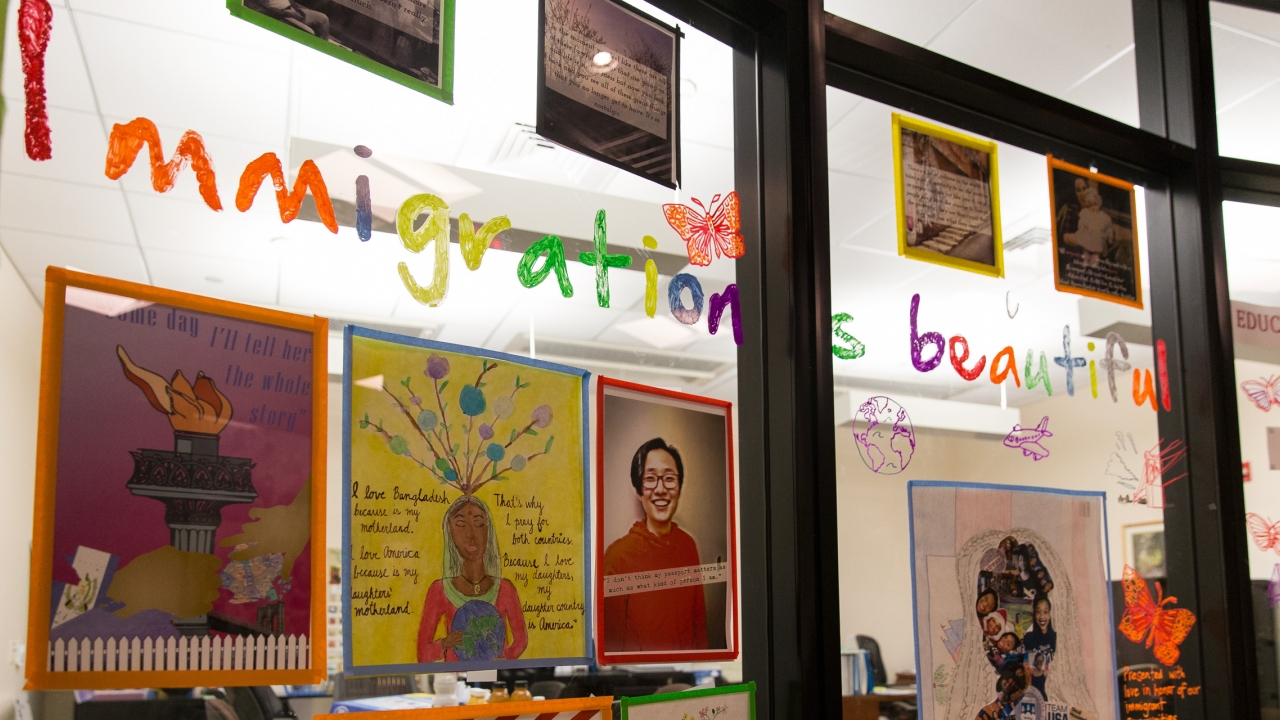Students’ Collage in Pendleton East Shows that Immigration Is Beautiful

On the glass wall of the education and American studies departments’ office, in Pendleton East, are three simple but powerful words painted in multicolored letters: “Immigration is beautiful.” Below and above that statement are images and photos that reflect how the students in Understanding Education through Immigrant Narratives view or have been affected by immigration.
Taught by Soo Hong, associate professor of education, the course examines how race, ethnicity, and social class shape immigrants’ educational and life trajectories. Her students put up the display in support of the May 1 observance of A Day Without Immigrants.
“In the current political climate, there is a temptation to view immigration as a threatening development that poses risk and danger; it was important to us as a group to challenge that narrative,” said Hong. “The contributions and experiences of immigrants shape who we are today and who we will become tomorrow, and we must seek to understand the goodness and rich complexity of that experience.”
The idea for the art project originated in conversations Hong and her 12 students had in class about the simplistic views of immigration that pervade the public and political discourse, including in American schools, she said. The group felt it was important to bring more diverse narratives to the public.
To do so, each student created a piece of art that reflected what she had learned about the richness of the immigrant experience through a semester-long research project that involved conducting a series of interviews with an immigrant and addressing a specific research question. In the exhibit, which will be up all summer, students’ artwork reflects images and quotations from their research participants that expressed the resiliency, determination, and complexity of the immigrant stories they told.
“As a scholar who studies activism and community organizing, I have always appreciated and understood the role that artists played in the civil rights and liberation struggles of the past,” said Hong. “Art allows us to integrate creativity and imagination into community building and organizing practices.”
The group held its last class meeting on Sunday, April 30, rather than its normal Monday meeting time, and arrived in the Education Department office with pizza, a playlist of songs, and the artwork that each student had created.
“I thought it would be a quick job of hanging up a dozen or so pieces of paper, but it really became a collaboration and celebration of our class and ourselves,” said Meredith Clark ’17, a psychology major and education studies minor.
“My piece was a collage of photographs of me, a Chinese-American adoptee, and my [childhood] friend, an Indian-born American who was the subject of my written portrait project,” Clark said. “Our parents made the decisions for Aditi and me to come to America, and our friends were largely immigrants themselves… The photographs of us together show how our lives are intertwined.”
As the students mounted their collage on the windows, Clark helped create frames for the art by taping colorful lines around everyone’s pieces. “I also drew an airplane on the window, since my and my friend’s families mostly immigrated via plane rather than by boat or on foot,” she said.
The collage utilizes many artistic approaches to demonstrate various experiences of immigration. The wide range of perspectives refutes the idea that immigrants must completely assimilate in order to be “good” and shows that those who are undocumented are motivated by the desire to provide for their families, not to violate immigration law.
Hong said those stories need to be told. “I’m an immigrant myself, and my own experience has left me feeling that the larger narrative about immigration is incomplete and inadequate,” she said. “Both the course and the collage have given my students, many of whom are immigrants themselves or have been directly affected by immigration, new language and contextual understanding to convey what they have felt and experienced.”
For Arianna Regalado ’18, a religion major and education studies minor, working on the collage was meaningful and deeply personal. “I contributed a picture of my mother, an immigrant from Mexico, hugging me as a baby, [along] with a quote from Latinx author Patricia Engel that reads, ‘All immigrants are artists because they create a life, a future, from nothing but a dream. The immigrant’s life is art in its purest form,’” she said.



